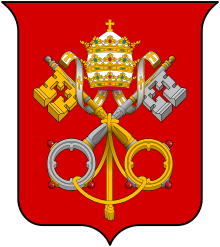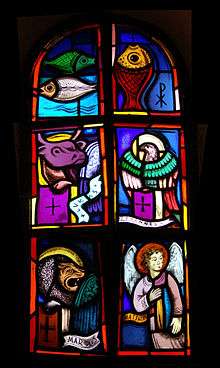Pope Anacletus
| Pope Saint Anacletus | |
|---|---|
 | |
| Papacy began | c. 79 |
| Papacy ended | c. 92 |
| Predecessor | Linus |
| Successor | Clement I |
| Personal details | |
| Born |
Unknown Rome, Italy, Roman Empire |
| Died |
c. 92 Rome, Italy, Roman Empire |
| Sainthood | |
| Feast day | 26 April |
| Venerated in | Roman Catholicism |
Pope Anacletus (died c. 92), also known as Cletus, was the third Bishop of Rome, following Saint Peter and Pope Linus. Anacletus served as pope between c. 79 and his death, c. 92.
Name and etymology
The name "Cletus" in Ancient Greek means "one who has been called," and "Anacletus" means "one who has been called back." Also "Anencletus" (Greek: Ανέγκλητος) means "unimpeachable."
The Roman Martyrology mentions the Pope in question only under the name of "Cletus." [1] The Annuario Pontificio gives both forms as alternatives. Eusebius, Saint Irenaeus, Saint Augustine and Optatus all suggest that both names refer to the same individual.
Papacy
St. Cletus/Anacletus was traditionally understood to have been a Roman who served as pope for twelve years. The Annuario Pontificio states, "For the first two centuries, the dates of the start and the end of the pontificate are uncertain." It gives the years 80 to 92 as the reign of Pope Cletus/Anacletus. Other sources give the years 77 to 88.
According to tradition, Pope Anacletus divided Rome into twenty-five parishes. One of the few surviving records concerning his papacy mentions him as having ordained an uncertain number of priests.
Burial
He died and was buried next to his predecessor, Saint Linus, near the grave of St. Peter's, in what is now Vatican City.[2] His name (as Cletus) is included in the Roman Canon of the Mass.
Veneration
The Tridentine Calendar reserved 26 April as the feast day of Saint Cletus, who the church honoured jointly with Saint Marcellinus, and 13 July for solely Saint Anacletus. In 1960, Pope John XXIII, while keeping the 26 April feast, which mentions the saint under the name given to him in the Canon of the Mass, removed 13 July as a feast day for Saint Anacletus. The 14 February 1961 Instruction of the Congregation for Rites on the application to local calendars of Pope John XXIII's motu proprio Rubricarum instructum of 25 July 1960, decreed that "the feast of 'Saint Anacletus,' on whatever ground and in whatever grade it is celebrated, is transferred to 26 April, under its right name, 'Saint Cletus.'" Use of this calendar, which is included in the 1962 edition of the Roman Missal, continues to be authorized under the conditions indicated in the motu proprio Summorum Pontificum; but the feast has been removed from the General Roman Calendar since 1969.[3] Although the day of his death is unknown,[3] Saint Cletus continues to be listed in the Roman Martyrology among the saints of 26 April.[4]
See also
Notes
References
- Donald Attwater and Catherine Rachel John, The Penguin Dictionary of Saints, 3rd edition, New York: Penguin Books, 1993. ISBN 0-14-051312-4.
- Louise Ropes Loomis, The Book of Popes (Liber Pontificalis). Merchantville, NJ: Evolution Publishing. ISBN 1-889758-86-8 (Reprint of the 1916 edition. (Ends with Pope Pelagius, who reigned from 579 until 590. English translation with scholarly footnotes, and illustrations).
- Richard P. McBrien, Lives of the Popes, (Harper, 2000). ISBN 0-06-065304-3
 This article incorporates text from a publication now in the public domain: Herbermann, Charles, ed. (1913). "Pope St. Anacletus". Catholic Encyclopedia. New York: Robert Appleton.
This article incorporates text from a publication now in the public domain: Herbermann, Charles, ed. (1913). "Pope St. Anacletus". Catholic Encyclopedia. New York: Robert Appleton.
External links
| Wikisource has original works written by or about: Anacletus |
- Writings attributed to Pope Anacletus/Cletus
- The Society of Pope Saint Anacletus, an Independent Catholic association in the United States
| Titles of the Great Christian Church | ||
|---|---|---|
| Preceded by Linus |
Bishop of Rome Pope 79–92 |
Succeeded by Clement I |

